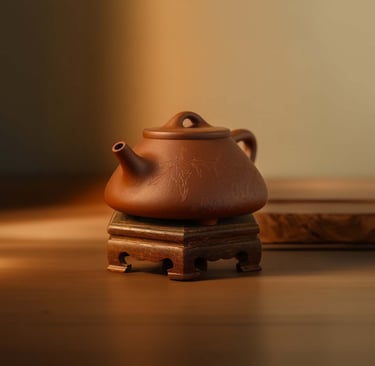What is the Chinese Tea Ceremony
Explore the Chinese tea ceremony, or "cha dao," which blends material craftsmanship with spiritual values. Delve into its origins, philosophy, and cultural significance, emphasizing mindfulness, purity, and respect.
CHINESE TEA CULTURETEA LIFE
The Chinese tea ceremony, or "cha dao" (茶道), isn’t just about brewing and drinking tea—it’s a bridge between the tangible and the spiritual. It reflects centuries of cultural wisdom, aesthetic beauty, and a way of life deeply rooted in balance and mindfulness. In this article, we’ll break down what makes the Chinese tea ceremony so special: its meaning, history, philosophy, and unique qualities.
Understanding the Chinese Tea Ceremony
The Concept of the Chinese Tea Ceremony
At its core, the Chinese tea ceremony is about way more than just pouring hot water over leaves. It’s a reflection of values, mindset, and an art form in itself. The word "dao" (道) means "the way" or "essence," and here, it refers to the harmonious relationship between people, tea, and nature.
The Ming dynasty scholar Zhang Yuan nailed it when he said tea requires precision in preparation, cleanliness in storage, and purity in brewing. Without these, tea is just another drink. But with them—and the right mindset—it becomes an experience.
At its heart, the tea ceremony balances the material aspects (like the tools, brewing techniques, and tea leaves) with the spiritual experience (appreciation, mindfulness, and connection).
The Origins and Evolution of the Chinese Tea Ceremony
The story of Chinese tea culture begins in the Tang dynasty with the legendary Lu Yu, author of The Classic of Tea (茶经). This wasn’t just a book; it was the manual on all things tea—covering origins, tools, brewing techniques, and the philosophy behind the practice.
Lu Yu didn’t just teach people how to make tea; he showed them how to experience it. For him, tea wasn’t just good for your health—it was good for your soul.
Later, scholars like Liu Zhenliang built on these ideas, highlighting the "Ten Virtues of Tea," which included respect, harmony, and mindfulness. Over time, tea evolved from being a simple drink to an art form and a spiritual practice.
The Philosophy of the Tea Ceremony
The Chinese tea ceremony philosophy revolves around three core principles:
Purity (净) – Tea clears your mind and helps you stay focused.
Tranquility (静) – It creates calmness, free from noise and distractions.
Respect (敬) – It fosters humility and gratitude, both for others and for nature.
Tea isn’t like alcohol—it doesn’t cloud your mind. Instead, it sharpens your focus and cultivates clarity.
These principles align perfectly with Confucian ideals of morality, Taoist principles of simplicity, and the Buddhist pursuit of mindfulness.
Characteristics of the Chinese Tea Ceremony
One of the most beautiful things about the Chinese tea ceremony is its simplicity and inclusiveness.
In ancient China, tea wasn’t reserved for the elite. Scholars enjoyed it in their quiet studies, farmers drank it in the fields, and emperors savoured it in their palaces.
Take the Yixing teapot as an example—it’s small, unassuming, and made from natural clay. But in its simplicity lies a deep connection to the ceremony’s essence.
This balance between simplicity and excellence is at the heart of the Chinese tea tradition.
Cultural Influences on the Tea Ceremony
Three major philosophies shaped the Chinese tea ceremony:
Confucianism: Focuses on harmony and moral growth, reflected in the balance and respect of the tea ritual.
Taoism: Emphasises simplicity and connection with nature, seen in the natural materials and peaceful atmosphere of tea preparation.
Buddhism: Introduces the concept of "Zen tea" (禅茶一味), where tea drinking becomes a form of meditation and mindfulness practice.
These influences turn a simple act of drinking tea into a practice of spiritual growth and personal refinement.
Conclusion
The Chinese tea ceremony isn’t just about tea—it’s about connection, simplicity, and mindfulness. It carries wisdom from centuries of culture, blending Confucian respect, Taoist simplicity, and Buddhist clarity into one practice.
Whether you’re brewing tea alone in a quiet corner or sharing it with friends, the tea ceremony invites you to slow down, appreciate the moment, and find harmony in the smallest details.
FAQs
1. What is the main purpose of the Chinese tea ceremony?
The ceremony aims to create harmony, mindfulness, and a deeper appreciation for life through the preparation and drinking of tea.
2. Who invented the Chinese tea ceremony?
The origins trace back to Lu Yu during the Tang dynasty, who wrote The Classic of Tea.
3. What are the key principles of the tea ceremony?
Purity, tranquility, and respect are the core principles.
4. What tools are used in the tea ceremony?
Common tools include the Yixing teapot, tea cups, and a brewing tray.
5. Is the Chinese tea ceremony still practiced today?
Absolutely! It’s still an important cultural tradition, enjoyed in both formal and casual settings worldwide.
In the end, the Chinese tea ceremony isn’t just about tea—it’s about a way of living, thinking, and connecting.


